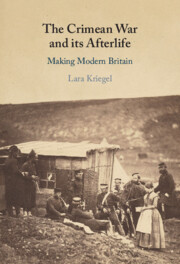23 results
3 - The Brave
- from Part II - Avatars
-
- Book:
- The Crimean War and its Afterlife
- Published online:
- 10 February 2022
- Print publication:
- 17 February 2022, pp 89-122
-
- Chapter
- Export citation
Part I - Persistence
-
- Book:
- The Crimean War and its Afterlife
- Published online:
- 10 February 2022
- Print publication:
- 17 February 2022, pp 19-86
-
- Chapter
- Export citation
Index
-
- Book:
- The Crimean War and its Afterlife
- Published online:
- 10 February 2022
- Print publication:
- 17 February 2022, pp 340-348
-
- Chapter
- Export citation
5 - The Heroine
- from Part III - Angels
-
- Book:
- The Crimean War and its Afterlife
- Published online:
- 10 February 2022
- Print publication:
- 17 February 2022, pp 161-199
-
- Chapter
- Export citation
Part III - Angels
-
- Book:
- The Crimean War and its Afterlife
- Published online:
- 10 February 2022
- Print publication:
- 17 February 2022, pp 159-244
-
- Chapter
- Export citation
Contents
-
- Book:
- The Crimean War and its Afterlife
- Published online:
- 10 February 2022
- Print publication:
- 17 February 2022, pp vii-vii
-
- Chapter
- Export citation
1 - The Adventurers
- from Part I - Persistence
-
- Book:
- The Crimean War and its Afterlife
- Published online:
- 10 February 2022
- Print publication:
- 17 February 2022, pp 21-54
-
- Chapter
- Export citation
Notes
-
- Book:
- The Crimean War and its Afterlife
- Published online:
- 10 February 2022
- Print publication:
- 17 February 2022, pp 245-315
-
- Chapter
- Export citation
Afterword: Do and Die
- from Part III - Angels
-
- Book:
- The Crimean War and its Afterlife
- Published online:
- 10 February 2022
- Print publication:
- 17 February 2022, pp 236-244
-
- Chapter
- Export citation
Part II - Avatars
-
- Book:
- The Crimean War and its Afterlife
- Published online:
- 10 February 2022
- Print publication:
- 17 February 2022, pp 87-158
-
- Chapter
- Export citation
2 - The Dutiful
- from Part I - Persistence
-
- Book:
- The Crimean War and its Afterlife
- Published online:
- 10 February 2022
- Print publication:
- 17 February 2022, pp 55-86
-
- Chapter
- Export citation
Acknowledgments
-
- Book:
- The Crimean War and its Afterlife
- Published online:
- 10 February 2022
- Print publication:
- 17 February 2022, pp xi-xvi
-
- Chapter
- Export citation
4 - The Custodians
- from Part II - Avatars
-
- Book:
- The Crimean War and its Afterlife
- Published online:
- 10 February 2022
- Print publication:
- 17 February 2022, pp 123-158
-
- Chapter
- Export citation
Bibliography
-
- Book:
- The Crimean War and its Afterlife
- Published online:
- 10 February 2022
- Print publication:
- 17 February 2022, pp 316-339
-
- Chapter
- Export citation
Introduction: The Reason Why
-
- Book:
- The Crimean War and its Afterlife
- Published online:
- 10 February 2022
- Print publication:
- 17 February 2022, pp 1-18
-
- Chapter
- Export citation
Figures
-
- Book:
- The Crimean War and its Afterlife
- Published online:
- 10 February 2022
- Print publication:
- 17 February 2022, pp viii-x
-
- Chapter
- Export citation
6 - The Foremother
- from Part III - Angels
-
- Book:
- The Crimean War and its Afterlife
- Published online:
- 10 February 2022
- Print publication:
- 17 February 2022, pp 200-235
-
- Chapter
- Export citation
Copyright page
-
- Book:
- The Crimean War and its Afterlife
- Published online:
- 10 February 2022
- Print publication:
- 17 February 2022, pp iv-iv
-
- Chapter
- Export citation
Dedication
-
- Book:
- The Crimean War and its Afterlife
- Published online:
- 10 February 2022
- Print publication:
- 17 February 2022, pp v-vi
-
- Chapter
- Export citation

The Crimean War and its Afterlife
- Making Modern Britain
-
- Published online:
- 10 February 2022
- Print publication:
- 17 February 2022

